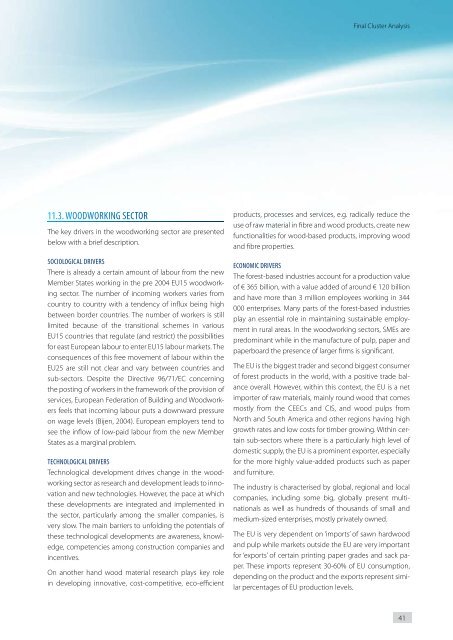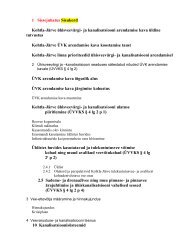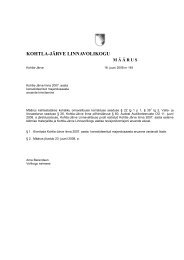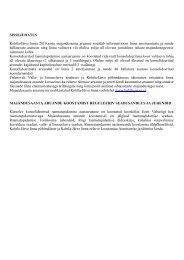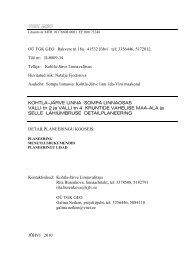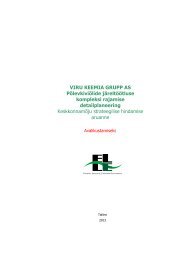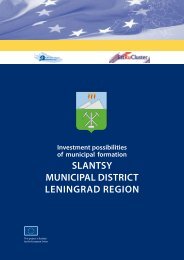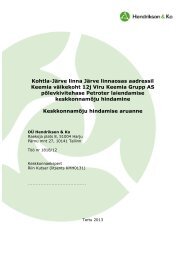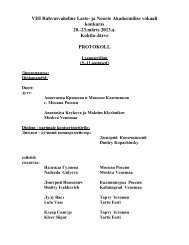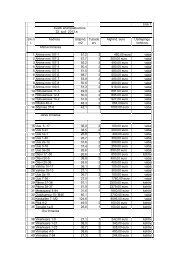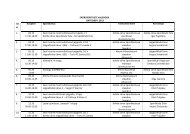FINAL CLUSTER ANALYSIS - Kohtla-Järve
FINAL CLUSTER ANALYSIS - Kohtla-Järve
FINAL CLUSTER ANALYSIS - Kohtla-Järve
You also want an ePaper? Increase the reach of your titles
YUMPU automatically turns print PDFs into web optimized ePapers that Google loves.
11.3. WooDWorKIng sector<br />
The key drivers in the woodworking sector are presented<br />
below with a brief description.<br />
socIologIcal DrIvers<br />
There is already a certain amount of labour from the new<br />
Member States working in the pre 2004 EU15 woodworking<br />
sector. The number of incoming workers varies from<br />
country to country with a tendency of infl ux being high<br />
between border countries. The number of workers is still<br />
limited because of the transitional schemes in various<br />
EU15 countries that regulate (and restrict) the possibilities<br />
for east European labour to enter EU15 labour markets. The<br />
consequences of this free movement of labour within the<br />
EU25 are still not clear and vary between countries and<br />
sub-sectors. Despite the Directive 96/71/EC concerning<br />
the posting of workers in the framework of the provision of<br />
services, European Federation of Building and Woodworkers<br />
feels that incoming labour puts a downward pressure<br />
on wage levels (Bijen, 2004). European employers tend to<br />
see the infl ow of low-paid labour from the new Member<br />
States as a marginal problem.<br />
technologIcal DrIvers<br />
Technological development drives change in the woodworking<br />
sector as research and development leads to innovation<br />
and new technologies. However, the pace at which<br />
these developments are integrated and implemented in<br />
the sector, particularly among the smaller companies, is<br />
very slow. The main barriers to unfolding the potentials of<br />
these technological developments are awareness, knowledge,<br />
competencies among construction companies and<br />
incentives.<br />
On another hand wood material research plays key role<br />
in developing innovative, cost-competitive, eco-effi cient<br />
Final Cluster Analysis<br />
products, processes and services, e.g. radically reduce the<br />
use of raw material in fi bre and wood products, create new<br />
functionalities for wood-based products, improving wood<br />
and fi bre properties.<br />
economIc DrIvers<br />
The forest-based industries account for a production value<br />
of € 365 billion, with a value added of around € 120 billion<br />
and have more than 3 million employees working in 344<br />
000 enterprises. Many parts of the forest-based industries<br />
play an essential role in maintaining sustainable employment<br />
in rural areas. In the woodworking sectors, SMEs are<br />
predominant while in the manufacture of pulp, paper and<br />
paperboard the presence of larger fi rms is signifi cant.<br />
The EU is the biggest trader and second biggest consumer<br />
of forest products in the world, with a positive trade balance<br />
overall. However, within this context, the EU is a net<br />
importer of raw materials, mainly round wood that comes<br />
mostly from the CEECs and CIS, and wood pulps from<br />
North and South America and other regions having high<br />
growth rates and low costs for timber growing. Within certain<br />
sub-sectors where there is a particularly high level of<br />
domestic supply, the EU is a prominent exporter, especially<br />
for the more highly value-added products such as paper<br />
and furniture.<br />
The industry is characterised by global, regional and local<br />
companies, including some big, globally present multinationals<br />
as well as hundreds of thousands of small and<br />
medium-sized enterprises, mostly privately owned.<br />
The EU is very dependent on ‘imports’ of sawn hardwood<br />
and pulp while markets outside the EU are very important<br />
for ‘exports’ of certain printing paper grades and sack paper.<br />
These imports represent 30-60% of EU consumption,<br />
depending on the product and the exports represent similar<br />
percentages of EU production levels.<br />
41


